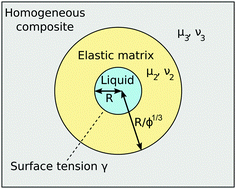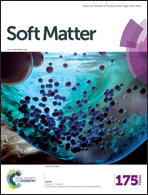Interfacial tension and a three-phase generalized self-consistent theory of non-dilute soft composite solids
Abstract
In the dilute limit Eshelby's inclusion theory captures the behavior of a wide range of systems and properties. However, because Eshelby's approach neglects interfacial stress, it breaks down in soft materials as the inclusion size approaches the elastocapillarity length L ≡ γ/E. Here, we use a three-phase generalized self-consistent method to calculate the elastic moduli of composites comprised of an isotropic, linear-elastic compliant solid hosting a spatially random monodisperse distribution of spherical liquid droplets. As opposed to similar approaches, we explicitly capture the liquid–solid interfacial stress when it is treated as an isotropic, strain-independent surface tension. Within this framework, the composite stiffness depends solely on the ratio of the elastocapillarity length L to the inclusion radius R. Independent of inclusion volume fraction, we find that the composite is stiffened by the inclusions whenever R < 3L/2. Over the same range of parameters, we compare our results with alternative approaches (dilute and Mori–Tanaka theories that include surface tension). Our framework can be easily extended to calculate the composite properties of more general soft materials where surface tension plays a role.


 Please wait while we load your content...
Please wait while we load your content...